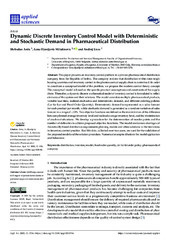Please use this identifier to cite or link to this item:
https://rfos.fon.bg.ac.rs/handle/123456789/2354Full metadata record
| DC Field | Value | Language |
|---|---|---|
| dc.creator | Antić, Slobodan | |
| dc.creator | Đorđević Milutinović, Lena | |
| dc.creator | Lisec, Andrej | |
| dc.date.accessioned | 2023-05-12T11:43:12Z | - |
| dc.date.available | 2023-05-12T11:43:12Z | - |
| dc.date.issued | 2022 | |
| dc.identifier.issn | 2076-3417 | |
| dc.identifier.uri | https://rfos.fon.bg.ac.rs/handle/123456789/2354 | - |
| dc.description.abstract | This paper presents an inventory control problem in a private pharmaceutical distribution company from the Republic of Serbia. The company realizes that distribution within nine neighbouring countries and inventory control in the pharmaceutical supply chain is centralized. In order to constitute a conceptual model of the problem, we propose the modern control theory concept. The conceptual model is based on the specific practical assumptions and constraints of the supply chain. Thereafter, a dynamic discrete mathematical model of inventory control is formulated to reflect elements of the system and their relations. The model considers multiple pharmaceutical products, variable lead time, realized stochastics and deterministic demand, and different ordering policies (Lot for Lot and Fixed Order Quantity). Deterministic demand is represented as a sales forecast for each product per month, while stochastic demand is generated as a random variation of sales forecast in a range of +/- 20%. Two objective functions are defined as the maximization of the difference between planned average inventory level and realized average inventory level, and the minimization of stock-out situations. We develop a procedure for the determination of reorder points and the number of deliveries to achieve proposed objective functions. The model overcomes shortages of theoretically-based distribution requirements planning models and offers solutions to the limitations in inventory control practice. Real-life data, collected over two years, are used for the validation of the proposed model and the solution procedure. Numerical examples illustrate the model application and behaviour. | en |
| dc.publisher | MDPI, Basel | |
| dc.rights | openAccess | |
| dc.rights.uri | https://creativecommons.org/licenses/by/4.0/ | |
| dc.source | Applied Sciences-Basel | |
| dc.subject | pharmaceutical company | en |
| dc.subject | lot for lot order policy | en |
| dc.subject | inventory model | en |
| dc.subject | fixed order quantity | en |
| dc.subject | distribution | en |
| dc.title | Dynamic Discrete Inventory Control Model with Deterministic and Stochastic Demand in Pharmaceutical Distribution | en |
| dc.type | article | |
| dc.rights.license | BY | |
| dc.citation.issue | 3 | |
| dc.citation.other | 12(3): - | |
| dc.citation.rank | M22~ | |
| dc.citation.volume | 12 | |
| dc.identifier.doi | 10.3390/app12031536 | |
| dc.identifier.fulltext | http://prototype2.rcub.bg.ac.rs/bitstream/id/863/2350.pdf | |
| dc.identifier.rcub | conv_2614 | |
| dc.identifier.scopus | 2-s2.0-85123771425 | |
| dc.identifier.wos | 000754628800001 | |
| dc.type.version | publishedVersion | |
| item.cerifentitytype | Publications | - |
| item.fulltext | With Fulltext | - |
| item.grantfulltext | open | - |
| item.openairetype | article | - |
| item.openairecristype | http://purl.org/coar/resource_type/c_18cf | - |
| Appears in Collections: | Radovi istraživača / Researchers’ publications | |
This item is licensed under a Creative Commons License


